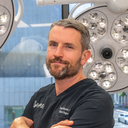An inverting periareolar incision after breast augmentation revision could be caused by several factors:





